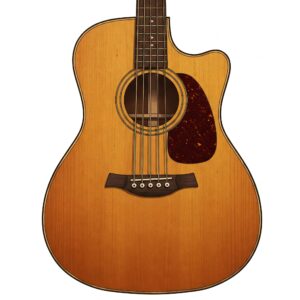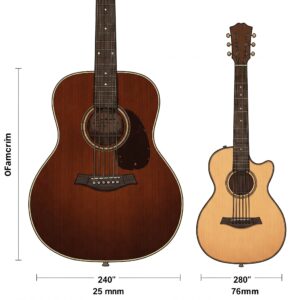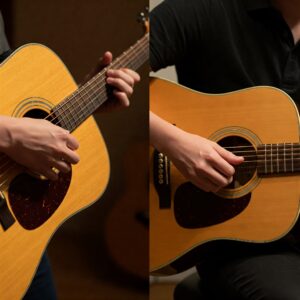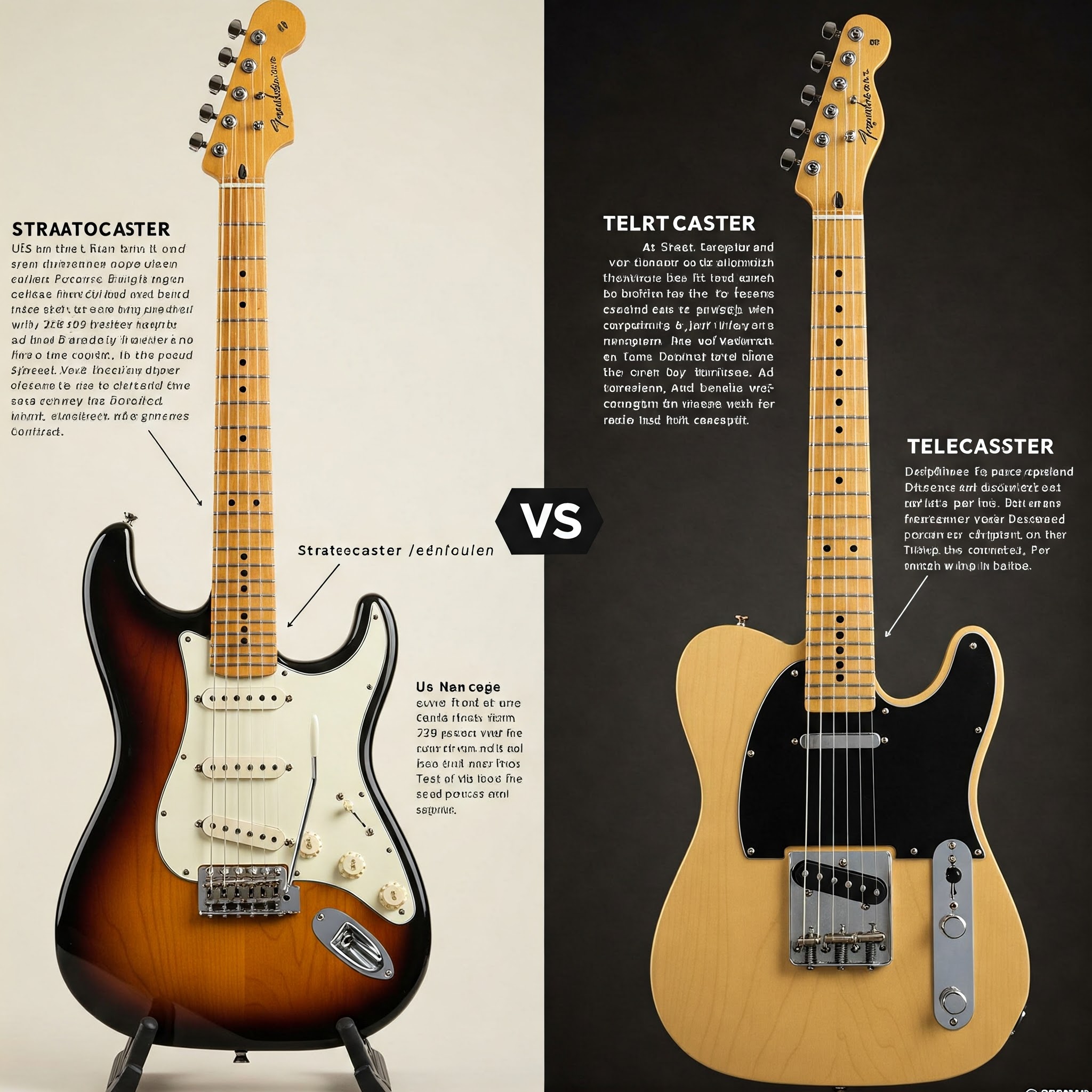Understanding Guitar Body Shapes 🎸
When I first stepped into a guitar shop, the overwhelming variety of shapes and sizes left me completely puzzled. Among the most common comparisons that beginners and even experienced players often contemplate is the classic debate of Dreadnought vs Concert guitar. These two popular body styles represent different approaches to sound, comfort, and playability that can significantly impact your musical journey.
As a guitarist with over 15 years of experience playing both styles across various genres, I’ve come to appreciate the subtle yet important distinctions between these two iconic shapes. Whether you’re shopping for your first acoustic guitar or adding to your collection, understanding the differences between Dreadnought vs Concert guitar models will help you make an informed decision that aligns with your playing style, physical comfort, and sonic preferences.
Throughout this comprehensive guide, we’ll explore everything from tone characteristics and physical dimensions to playing comfort and ideal musical genres for each body style. By the end, you’ll have a clear understanding of which guitar type might be your perfect match. Let’s dive into the world of guitar body shapes and discover which one speaks to your musical soul! 🎵

What is a Dreadnought Guitar? 🔊
The Dreadnought guitar is named after the massive early 20th-century British battleships, and true to its namesake, it’s known for its bold presence both visually and sonically. Martin Guitar Company introduced this revolutionary design in 1916, forever changing the landscape of acoustic guitars.
Key Characteristics of Dreadnought Guitars ✅
When examining a Dreadnought vs Concert guitar comparison, several distinctive features of the Dreadnought immediately stand out:
- 🔷 Size and Shape: Larger body with broad shoulders and a wide waist
- 🔷 Sound Profile: Powerful, boomy bass response with strong projection
- 🔷 Volume: Naturally louder with greater dynamic range
- 🔷 Body Dimensions: Typically around 20″ long, 15-16″ wide, and 4-5″ deep
- 🔷 Playing Experience: Requires slightly more arm reach but delivers substantial volume
The Dreadnought’s larger sound chamber creates a resonant, room-filling sound that has made it the go-to choice for countless professional musicians. Moreover, this guitar shape produces a balanced tonal spectrum with emphasized low-end frequencies that create a solid foundation for many musical styles.
However, the size and shape of a Dreadnought guitar also present certain considerations. The larger body can sometimes feel unwieldy for smaller players or those seeking a more intimate playing experience. Additionally, while the Dreadnought excels in projection and volume, it may sometimes overpower softer playing styles or fingerpicking techniques.
Popular Dreadnought Models Worth Considering 🌟
If you’re leaning toward the Dreadnought side of the Dreadnought vs Concert guitar debate, here are some outstanding models currently available:
✅ Martin D-28 Standard Dreadnought Acoustic Guitar stands as the gold standard of Dreadnought guitars with its legendary tone and impeccable build quality. The East Indian rosewood back and sides paired with a Sitka spruce top create the quintessential Dreadnought sound that has defined American music for generations.
✅ Taylor 210ce Dreadnought Acoustic-Electric Guitar offers impressive playability with a slightly more modern take on the Dreadnought shape. Its comfortable neck profile and reliable electronics make it an excellent choice for performers who need amplified sound without sacrificing acoustic tone.
✅ Yamaha FG800 Solid Top Dreadnought Acoustic Guitar presents an incredible value proposition for beginners and intermediate players. Despite its budget-friendly price point, it features a solid spruce top and delivers surprising tone quality that has made it a bestseller for years.
| Dreadnought Model | Price Range | Best For |
|---|---|---|
| Martin D-28 | $2,500 – $3,000 | Professional players, recording, bluegrass |
| Taylor 210ce | $1,000 – $1,500 | Performing musicians, versatile playing styles |
| Yamaha FG800 | $200 – $300 | Beginners, budget-conscious players |
→ Elevate Your Playing Experience with Premium Dreadnoughts! 🔥
🎸 Ready to experience the powerful voice of a quality Dreadnought? These carefully selected models represent the best in their class for various budgets. Click on any highlighted guitar to check current pricing and read verified player reviews from fellow musicians! 🎸

What is a Concert Guitar? 🎵
On the other side of the Dreadnought vs Concert guitar spectrum is the more compact and versatile Concert guitar. Also known as O-style or Orchestra Model guitars, Concert guitars were originally designed to blend with orchestral instruments, offering clarity and articulation rather than sheer volume.
Key Characteristics of Concert Guitars ✅
When comparing Dreadnought vs Concert guitar designs, the Concert style offers several distinctive features:
- 🔷 Size and Shape: Smaller body with narrower waist and more pronounced curves
- 🔷 Sound Profile: Balanced frequency response with articulate midrange and clearer trebles
- 🔷 Volume: Moderate projection with greater tonal definition
- 🔷 Body Dimensions: Approximately 18-19″ long, 13-14″ wide, and 3.5-4.5″ deep
- 🔷 Playing Experience: More comfortable for smaller players or those seeking physical comfort
The Concert guitar’s more intimate dimensions create a playing experience that many fingerstyle players and singer-songwriters prefer. Furthermore, its balanced tonal character provides excellent note separation and clarity that makes complex chord voicings and delicate fingerpicking patterns shine through with remarkable definition.
One of the most appealing aspects of Concert guitars in the Dreadnought vs Concert guitar debate is their versatility across playing styles. While they may not dominate a bluegrass jam circle like a Dreadnought would, they excel in recording situations where tonal balance is crucial and in performance settings where amplification negates the need for maximum acoustic volume.
Popular Concert Models Worth Considering 🌟
If the Concert guitar’s characteristics appeal to you in the Dreadnought vs Concert guitar comparison, consider these excellent models:
✅ Martin OM-28 Orchestra Model Acoustic Guitar represents the pinnacle of Concert-style instruments with its legendary articulation and balance. The orchestra model (OM) design delivers the perfect combination of comfort and sound quality that has made it a favorite among fingerstyle specialists and professional recording artists.
✅ Taylor 412ce Grand Concert Acoustic-Electric Guitar showcases Taylor’s innovative approach to the Concert body style with exceptional playability and tonal clarity. Its sophisticated electronics and comfortable dimensions make it ideal for performers who need precise amplified sound reproduction.
✅ Yamaha CSF3M Parlor Acoustic-Electric Guitar offers a compact take on the Concert shape that’s perfect for travel while delivering surprising fullness of tone. Its solid wood construction and built-in electronics provide remarkable value in a highly portable package.
| Concert Model | Price Range | Best For |
|---|---|---|
| Martin OM-28 | $2,800 – $3,300 | Professional fingerstylists, recording artists |
| Taylor 412ce | $2,500 – $3,000 | Performers, fingerstyle players, versatile musicians |
| Yamaha CSF3M | $550 – $650 | Travelers, apartment dwellers, recording |
Dreadnought vs Concert Guitar: 7 Key Differences 🔍
Now that we’ve examined both guitar types individually, let’s explore the direct comparisons that highlight the essential differences between Dreadnought vs Concert guitar styles. Understanding these distinctions will help you determine which guitar type best suits your playing style and musical preferences.
1. Size and Comfort ✅
The most immediately obvious difference in the Dreadnought vs Concert guitar comparison is physical size:
- 🔷 Dreadnought: Larger body that can sometimes feel cumbersome for smaller players or when playing seated
- 🔷 Concert: More compact frame that typically offers greater comfort, especially for long playing sessions
The comfort factor cannot be overstated when choosing between these two styles. Many players who started with Dreadnoughts eventually transition to Concert guitars as they age or develop their technique. In contrast, some players find the Dreadnought’s substantial presence more satisfying and worth the slight compromise in comfort.
The Concert guitar’s smaller dimensions make it particularly suitable for players with smaller frames, younger musicians, or those who experience discomfort with larger instruments. Nevertheless, players of all sizes can enjoy either guitar type with proper positioning and technique.
2. Tonal Characteristics ✅
Perhaps the most significant distinction in the Dreadnought vs Concert guitar debate lies in their sonic properties:
- 🔷 Dreadnought: Emphasizes low and mid-low frequencies with powerful bass response and strong fundamental notes
- 🔷 Concert: Delivers more balanced frequency response with clearer midrange and articulate trebles
The Dreadnought’s tonal profile creates a robust foundation that supports vocal accompaniment and cuts through in group settings. Furthermore, its stronger bass response gives strummed chords a powerful presence that can drive a song forward with remarkable authority.
Conversely, the Concert guitar offers greater tonal separation between notes, making complex chord voicings and intricate fingerpicking patterns more distinct. Additionally, its more balanced EQ profile often requires less adjustment when recording or amplifying the instrument.
3. Volume and Projection ✅
When considering Dreadnought vs Concert guitar differences, volume is a critical factor:
- 🔷 Dreadnought: Naturally louder with greater projection and room-filling capabilities
- 🔷 Concert: Moderate volume with improved focus and directional sound
The Dreadnought’s larger sound chamber creates naturally higher volume that made it revolutionary when first introduced. Moreover, this projection capability remains valuable in acoustic environments where amplification isn’t available.
The Concert guitar produces a more focused sound that, while not as loud acoustically, often translates better to microphones and pickups. Additionally, its more controlled volume makes it ideal for intimate settings where nuance matters more than sheer volume.

4. Playing Styles and Techniques ✅
Different body styles lend themselves to different playing approaches in the Dreadnought vs Concert guitar comparison:
- 🔷 Dreadnought: Excels with strumming, flatpicking, and rhythm playing
- 🔷 Concert: Shines with fingerpicking, arpeggios, and complex playing techniques
The Dreadnought’s design responds beautifully to forceful strumming and flatpicking techniques that take advantage of its powerful dynamic range. Furthermore, its robust sound makes it perfect for rhythm guitar roles in bands and ensemble settings.
Concert guitars offer exceptional note definition that highlights the subtleties of fingerstyle playing and intricate techniques. Moreover, their responsive nature allows for greater dynamic control between soft and moderate playing volumes, though they may compress more quickly at maximum attack.
5. Musical Genres ✅
While both guitar types are versatile, certain musical styles traditionally favor one over the other in the Dreadnought vs Concert guitar debate:
- 🔷 Dreadnought: Traditional favorite for bluegrass, country, rock, and folk-rock
- 🔷 Concert: Often preferred for fingerstyle, classical-influenced styles, jazz, and contemporary folk
The Dreadnought’s powerful voice has made it the historical choice for genre pioneers in American roots music. Additionally, its ability to cut through other instruments makes it valuable in ensemble settings where acoustic instruments need to be heard without amplification.
Concert guitars have gained popularity across numerous genres where tonal articulation and comfort are prioritized over maximum volume. Furthermore, their balanced frequency response makes them excellent studio instruments for recording situations where tonal clarity is paramount.
6. Playability and Action ✅
The physical dimensions affect playability in several ways when comparing Dreadnought vs Concert guitar designs:
- 🔷 Dreadnought: Often requires slightly more arm reach and can have higher action for greater projection
- 🔷 Concert: Typically features lower action and requires less reach, making it more accessible
The Dreadnought’s larger body sometimes necessitates higher action (string height) to prevent buzzing given its powerful resonance. Moreover, reaching around its broader body can require more extension, particularly for players with shorter arms.
Concert guitars generally allow for lower action while maintaining clarity, contributing to their reputation for playability. Additionally, their more compact dimensions make complex fretting positions more accessible for many players.
7. Price and Value Considerations ✅
When evaluating Dreadnought vs Concert guitar options, price factors can influence the decision:
- 🔷 Dreadnought: Available across all price points with exceptional value in entry-level to mid-range models
- 🔷 Concert: Tend to begin at slightly higher price points with premium features more common
The Dreadnought’s widespread popularity has made it available at virtually every price point, from budget-friendly beginner instruments to professional-grade heirloom guitars. Furthermore, their standardized design often delivers consistent quality across manufacturers.
Concert guitars frequently feature more precise craftsmanship given their emphasis on tonal balance and playability. Additionally, their refined design elements sometimes command higher prices, though excellent values can still be found with careful shopping.
→ Find Your Perfect Match Today! 🌟
🎵 Whether you’re drawn to the powerful voice of a Dreadnought or the balanced clarity of a Concert guitar, the perfect instrument is just a click away. Browse these carefully curated options now to discover the guitar that will inspire your musical journey for years to come! 🎵

Which Style Should You Choose? Making the Decision 🤔
After exploring the various aspects of the Dreadnought vs Concert guitar comparison, how do you determine which is right for you? Here are some practical considerations to guide your decision:
Consider Your Physical Comfort First ✅
Before all other factors, the guitar should feel comfortable in your hands and against your body. Try sitting with both styles for extended periods if possible. Pay attention to how your arm reaches over the body and whether the size feels natural to your frame.
Many players who initially struggled with guitar eventually discovered they were fighting against an inappropriate body size. Consequently, finding the right physical match can make a tremendous difference in your playing enjoyment and progress.
If you have a smaller frame or experience discomfort with larger instruments, the Concert guitar might offer a more natural fit. Conversely, if you prefer the substantial feel of a larger instrument, the Dreadnought could provide a more satisfying physical experience.
Evaluate Your Playing Style ✅
Your preferred techniques should heavily influence your choice in the Dreadnought vs Concert guitar decision:
- 🔷 For Strummers: If you primarily strum chords and play rhythm, a Dreadnought may better serve your needs
- 🔷 For Fingerpickers: If you focus on fingerstyle playing, a Concert guitar will likely highlight your technique
- 🔷 For Versatile Players: Consider which techniques you use more frequently or which sonic qualities you value most
Many versatile players eventually own both types to cover different playing situations and musical requirements. However, if starting with one, prioritize the body style that complements your most frequently used techniques.
Consider Your Musical Context ✅
Where and how you play significantly impacts the Dreadnought vs Concert guitar decision:
- 🔷 Solo Performer: Either style works well, depending on venue size and amplification availability
- 🔷 Band Setting: Dreadnought may cut through better in acoustic ensembles
- 🔷 Home Player: Concert might be more comfortable for casual playing
- 🔷 Recording Artist: Concert often captures better in studio environments
Consider where you play most frequently and under what conditions. Additionally, think about whether you typically have access to amplification or depend solely on acoustic projection.
Try Before You Buy (If Possible) ✅
The most valuable advice in the Dreadnought vs Concert guitar debate is to play both types before making a decision. Every player’s experience is subjective, and what works for others may not work for you.
Visit local music stores and play multiple examples of each body style across different price points. Furthermore, pay attention to both the sound and feel, giving equal weight to comfort and tonal characteristics.
If in-person testing isn’t possible, look for detailed video demonstrations that showcase both guitar types playing similar material, preferably with the same strings and playing techniques for fair comparison.

Hybrid and Alternative Options 🔄
The Dreadnought vs Concert guitar comparison isn’t always strictly binary. Many manufacturers now offer modified or hybrid designs that blend characteristics of both styles:
Modified Dreadnoughts ✅
Several brands have created “slope-shouldered” or “modified” Dreadnoughts that maintain much of the traditional Dreadnought’s power while offering improved comfort:
- 🔷 Gibson J-45 features a rounded-shoulder Dreadnought design that many find more comfortable while retaining substantial bass response
- 🔷 Martin DSS (Dreadnought Slope Shoulder) models blend traditional Dreadnought power with more comfortable contours
These modified designs can provide an excellent middle ground for players torn between the two main body styles in the Dreadnought vs Concert guitar comparison.
Grand Auditorium / Grand Performance Guitars ✅
Many manufacturers have developed body shapes that aim to combine the best aspects of both Dreadnought and Concert designs:
- 🔷 Taylor Grand Auditorium body shape (found in their 300, 400, 500 series, etc.) offers balanced tone with comfortable dimensions
- 🔷 Martin Grand Performance models provide enhanced bass response in a more comfortable package than traditional Dreadnoughts
These “best of both worlds” designs have become increasingly popular as they address many of the trade-offs typically associated with the Dreadnought vs Concert guitar decision.
For players struggling to decide between the two traditional body styles, these hybrid designs are well worth exploring as they may offer the ideal compromise between comfort and sound.
Caring for Your Guitar: Maintenance Tips 🧹
Regardless of whether you choose a Dreadnought vs Concert guitar, proper maintenance will ensure your instrument sounds its best and lasts for generations:
Climate Control Essentials ✅
All acoustic guitars are sensitive to humidity and temperature changes:
- 🔷 Ideal Conditions: 45-55% relative humidity and 70-75°F (21-24°C)
- 🔷 Humidification: Use in-case humidifiers in dry climates or during winter heating season
- 🔷 Dehumidification: Consider dehumidifiers or climate control in extremely humid environments
Dreadnought guitars, with their larger surface area, may sometimes be more susceptible to climate-related issues. Moreover, their larger soundboards can make them slightly more prone to top bulging in high humidity or cracking in extremely dry conditions.
Concert guitars, while still requiring proper humidity care, may sometimes be marginally more stable due to their smaller dimensions and reduced tension. Nevertheless, both guitar types demand attentive humidity management for longevity.
Investing in a quality hygrometer to monitor conditions and appropriate humidification solutions will protect your investment regardless of which body style you choose in the Dreadnought vs Concert guitar debate.
String Replacement and Setup ✅
Different body styles may benefit from different string choices:
- 🔷 Dreadnought: Often sounds best with medium gauge strings (0.013-0.056) that maximize its powerful voice
- 🔷 Concert: Frequently pairs well with light or custom light gauge strings (0.012-0.053 or 0.011-0.052) that enhance its articulation
Regular string changes (every 1-3 months for active players) will maintain optimal tone quality. Furthermore, periodic professional setups can address action height, intonation, and playability issues that develop over time.
Both Dreadnought vs Concert guitar styles benefit from professional adjustment approximately once yearly or whenever significant seasonal changes occur. Additionally, keeping the instrument clean and properly stored when not in use will preserve its finish and structural integrity.
→ Upgrade Your Guitar Experience Today! ⭐
🛠️ Ready to get the most from your guitar, whether Dreadnought or Concert? The highlighted accessories and care products above will keep your instrument in peak condition. Click any link to explore these essential maintenance tools that will protect your musical investment for years to come! 🛠️

Conclusion: Finding Your Perfect Match 🏆
The Dreadnought vs Concert guitar debate ultimately comes down to personal preference and playing requirements. Both designs have earned their place in music history for good reason – they excel at different aspects of the acoustic guitar experience.
The Dreadnought offers powerful projection, robust bass, and commanding presence that makes it perfect for strummers, performers in acoustic settings, and players who appreciate a substantial instrument with room-filling sound. Throughout its century-plus history, it has defined the sound of countless musical genres and remains the benchmark against which other acoustic guitars are measured.
The Concert guitar provides balanced tone, exceptional comfort, and articulate note definition that suits fingerstylists, recording artists, and players who prioritize playability and tonal complexity. Its more intimate dimensions create a different relationship between player and instrument that many find more conducive to expressive playing.
Many serious guitarists eventually add both body styles to their collection, recognizing that each has its place in different musical contexts. If beginning your journey with one, choose based on physical comfort first, then playing style and musical genre preferences.
Remember that individual guitars, even within the same body style category, can vary significantly. The specific tonewoods, construction methods, and craftsmanship will influence the sound and feel as much as the basic body dimensions. Take your time, play as many examples as possible, and trust your ears and hands to guide you to the right instrument.
Whether you choose a Dreadnought vs Concert guitar, the perfect instrument is one that inspires you to play more often and supports your musical expression. The best guitar for you is ultimately the one that feels like an extension of yourself and brings joy every time you pick it up.
→ Start Your Guitar Journey Right Now! 🎸
🔥 Whether you’ve decided on a Dreadnought or Concert guitar, the perfect instrument is waiting for you. Click on any of our recommended models to check current pricing and make your selection today. Your musical adventure begins with choosing the right guitar that will inspire you for years to come! 🔥

More FAQs:
❓ Which guitar is louder, dreadnought or concert?
✅ Dreadnought guitars are typically louder than concert guitars due to their larger body size, which allows for greater volume and stronger bass projection…
❓ Is a concert guitar easier to play than a dreadnought?
✅ Yes, concert guitars are generally easier to handle and play, especially for beginners or players with smaller hands, thanks to their slimmer body and lighter build…
❓ Which guitar is better for fingerpicking, dreadnought or concert?
✅ Concert guitars are often preferred for fingerpicking because of their balanced tone and quicker response, while dreadnoughts favor strumming with more low-end power…
❓ Does the guitar body shape affect sound quality?
✅ Yes, body shape significantly influences tone. Dreadnoughts produce deeper, bolder sounds, while concert guitars offer more clarity and midrange focus…
❓ Should beginners start with a dreadnought or concert guitar?
✅ Beginners often find concert guitars more comfortable due to their smaller size and softer playability, while dreadnoughts may suit those who prioritize fuller sound for strumming…
Recommended for You:
- Acoustic vs Classical Guitar: 10 Must-Know Differences Before You Buy in 2025
- Acoustic Guitar vs Electric Guitar: 10 Essential Insights to Make the Right Choice in 2025
- Bass Guitar vs Electric Guitar: 10 Exciting Facts Every Musician Should Know
Disclaimer: This article contains affiliate links. If you purchase products through these links, we may earn a small commission at no additional cost to you.




